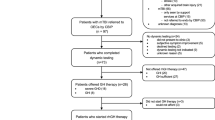Abstract
Introduction
Relative adrenal insufficiency has been shown to occur in the settings of critical illness and septic shock, impairing the body’s ability to respond to stress. Studies have demonstrated that the treatment of adrenal insufficiency (AI) results in shock reversal, hemodynamic stability, and a subsequent decrease in mortality. Endocrine changes and AI have been reported in patients with spinal cord injuries during their extended courses of rehabilitation.
Discussion
We describe two cases of patients with cervical spine injuries who presented with acute adrenal insufficiency following their injuries. With the addition of low-dose corticosteroids, each patient had symptom resolution and demonstrated clinical improvement.
Conclusion
Patients with spinal cord injuries are at risk for AI, both in the acute and chronic settings following injury prompting the need for an increased awareness of this condition. Although variability exists in the exact criteria for the diagnosis of AI, the combination of clinical symptoms, depressed serum cortisol concentrations, and responsiveness to exogenous steroid therapy should all contribute to the diagnosis of this condition.
Similar content being viewed by others
References
Cooper MS, Stewart PM. Corticosteroid insufficiency in acutely ill patients. N Engl J Med 2003;348(8):727–34.
Garcia-Zozaya IA. Adrenal insufficiency in acute spinal cord injury. J Spinal Cord Med 2006;29(1):67–9.
Lecamwasam HS, Baboolal HA, Dunn PF. Acute adrenal insufficiency after large-dose glucocorticoids for spinal cord injury. Anesth Analg 2004;99(6):1813–4.
Annane D, Sebille V, Charpentier C, et al. Effect of treatment with low doses of hydrocortisone and fludrocortisone on mortality in patients with septic shock. JAMA 2002;288(7):862–71.
Dellinger RP, Carlet JM, Masur H et al. Surviving Sepsis Campaign guidelines for management of severe sepsis and septic shock. Crit Care Med 2004;32(3):858–73.
Siraux V, De Backer D, Yalavatti G, et al. Relative adrenal insufficiency in patients with septic shock: comparison of low-dose and conventional corticotropin tests. Crit Care Med 2005;33(11):2479–86.
Kozyra EF, Wax RS, Burry LD. Can 1 microg of cosyntropin be used to evaluate adrenal insufficiency in critically ill patients? Ann Pharmacother 2005;39(4):691–8.
Marik PE, Zaloga GP. Adrenal insufficiency during septic shock. Crit Care Med 2003;31(1):141–5.
Rothwell PM, Udwadia ZF, Lawler PG. Cortisol response to corticotropin and survival in septic shock. Lancet 1991;337(8741):582–3.
Huang TS, Wang YH, Lee SH, Lai JS. Impaired hypothalamus-pituitary-adrenal axis in men with spinal cord injuries. Am J Phys Med Rehabil 1998;77(2):108–12.
Wang YH, Huang TS. Impaired adrenal reserve in men with spinal cord injury: results of low- and high-dose adrenocorticotropin stimulation tests. Arch Phys Med Rehabil 1999;80(8):863–6.
Brodows RG, Pi-Sunyer FX, Campbell RG. Neural control of counter-regulatory events during glucopenia in man. J Clin Invest 1973;52(8):1841–4.
Daniel PM, Prichard MM, Treip CS. Traumatic infarction of the anterior lobe of the pituitary gland. Lancet 1959;2:927–31.
Ceballos R. Pituitary changes in head trauma (analysis of 102 consecutive cases of head injury). Ala J Med Sci 1966;3(2):185–98.
Kornblum RN, Fisher RS. Pituitary lesions in craniocerebral injuries. Arch Pathol 1969;88(3):242–8.
Crompton MR. Hypothalamic lesions following closed head injury. Brain 1971;94(1):165–72.
Cohan P, Wang C, McArthur DL, et al. Acute secondary adrenal insufficiency after traumatic brain injury: a prospective study. Crit Care Med 2005;33(10):2358–66.
Dimopoulou I, Tsagarakis S, Douka E, et al. The low-dose corticotropin stimulation test in acute traumatic and non-traumatic brain injury: incidence of hypo-responsiveness and relationship to outcome. Intensive Care Med 2004;30(6):1216–9.
Agha A, Rogers B, Mylotte D, et al. Neuroendocrine dysfunction in the acute phase of traumatic brain injury. Clinical Endocrinol 2004;60(5):584–91.
Powner DJ, Boccalandro C, Alp MS, Vollmer DG. Endocrine failure after traumatic brain injury in adults. Neurocrit Care 2006;5(1):61–70.
Absalom A, Pledger D, Kong A. Adrenocortical function in critically ill patients 24 h after a single dose of etomidate. Anaesthesia 1999;54(9):861–7.
Author information
Authors and Affiliations
Corresponding author
Rights and permissions
About this article
Cite this article
Weant, K.A., Sasaki-Adams, D., Kilpatrick, M. et al. Relative Adrenal Insufficiency in Patients with Acute Spinal Cord Injury. Neurocrit Care 8, 53–56 (2008). https://doi.org/10.1007/s12028-007-9003-5
Published:
Issue Date:
DOI: https://doi.org/10.1007/s12028-007-9003-5




